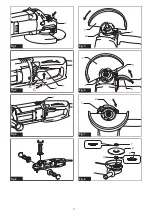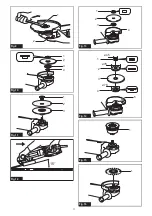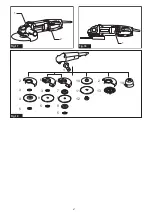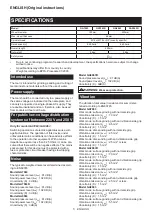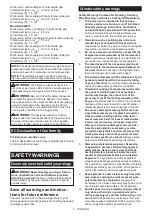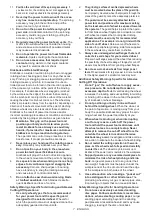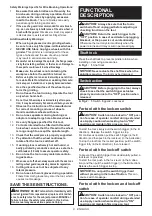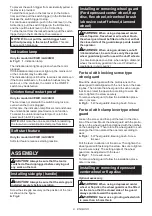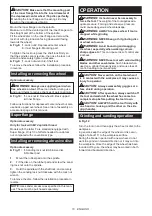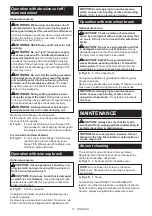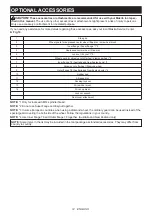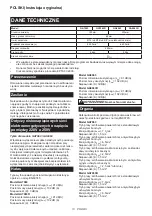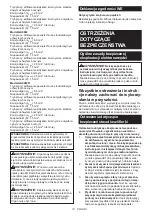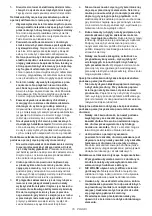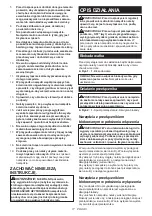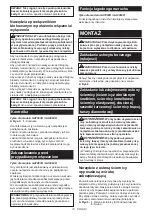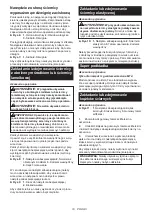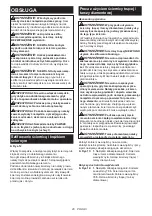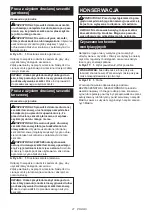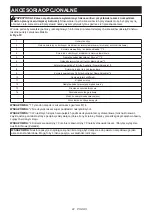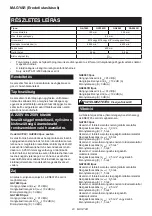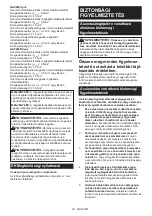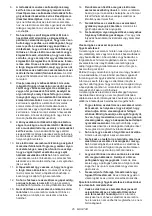
10 ENGLISH
CAUTION:
Make sure that the mounting part
of the inner flange fits into the inner diameter of
the depressed center wheel / flap disc perfectly.
Mounting the inner flange on the wrong side may
result in the dangerous vibration.
Mount the inner flange onto the spindle.
Make sure to fit the dented part of the inner flange onto
the straight part at the bottom of the spindle.
Fit the wheel/ disc on the inner flange and screw the
lock nut with its protrusion facing downward (facing
towards the wheel).
►
Fig.8:
1.
Lock nut
2.
Depressed center wheel
3.
Inner flange
4.
Mounting part
To tighten the lock nut, press the shaft lock firmly so
that the spindle cannot revolve, then use the lock nut
wrench and securely tighten clockwise.
►
Fig.9:
1.
Lock nut wrench
2.
Shaft lock
To remove the wheel, follow the installation procedure
in reverse.
Installing or removing flex wheel
Optional accessory
WARNING:
Always use supplied guard when
flex wheel is on tool.
Wheel can shatter during use
and guard helps to reduce chances of personal injury.
►
Fig.10:
1.
Lock nut
2.
Flex wheel
3.
Back up pad
4.
Inner flange
Follow instructions for depressed center wheel but also
use back up pad over wheel. See order of assembly on
accessories page in this manual.
Super flange
Optional accessory
Only for tools with M14 spindle thread.
Models with the letter F are standard-equipped with
Super flange. Only 1/3 of efforts needed to undo lock
nut, compared with conventional type.
Installing or removing abrasive disc
Optional accessory
►
Fig.11:
1.
Sanding lock nut
2.
Abrasive disc
3.
Rubber pad
1.
Mount the rubber pad onto the spindle.
2.
Fit the disc on the rubber pad and screw the sand
-
ing lock nut onto the spindle.
3.
Hold the spindle with the shaft lock, and securely
tighten the sanding lock nut clockwise with the lock nut
wrench.
To remove the disc, follow the installation procedure in
reverse.
NOTE:
Use sander accessories specified in this man
-
ual. These must be purchased separately.
OPERATION
WARNING:
It should never be necessary to
force the tool.
The weight of the tool applies ade
-
quate pressure. Forcing and excessive pressure
could cause dangerous wheel breakage.
WARNING:
ALWAYS replace wheel if tool is
dropped while grinding.
WARNING:
NEVER bang or hit grinding disc
or wheel onto work.
WARNING:
Avoid bouncing and snagging
the wheel, especially when working corners,
sharp edges etc.
This can cause loss of control and
kickback.
WARNING:
NEVER use tool with wood cutting
blades and other saw blades.
Such blades when
used on a grinder frequently kick and cause loss of
control leading to personal injury.
CAUTION:
Never switch on the tool when it
is in contact with the workpiece, it may cause an
injury to operator.
CAUTION:
Always wear safety goggles or a
face shield during operation.
CAUTION:
After operation, always switch off
the tool and wait until the wheel has come to a
complete stop before putting the tool down.
CAUTION:
ALWAYS hold the tool firmly with
one hand on housing and the other on the side
grip (handle).
Grinding and sanding operation
►
Fig.12
Turn the tool on and then apply the wheel or disc to the
workpiece.
In general, keep the edge of the wheel or disc at an
angle of about 15° to the workpiece surface.
During the break-in period with a new wheel, do not
work the grinder in forward direction or it may cut into
the workpiece. Once the edge of the wheel has been
rounded off by use, the wheel may be worked in both
forward and backward direction.


